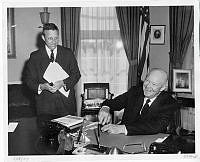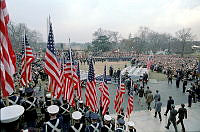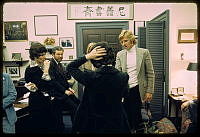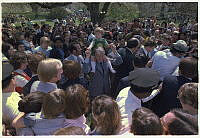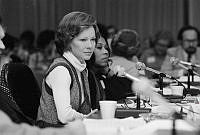Richard M. Nixon

When Richard Nixon was elected in 1968, he declared that his goal was “to bring the American people together.” The nation was divided, with turbulence in the cities and war overseas. During his presidency, Nixon ended American fighting in Vietnam, improved relations with the Soviet Union, and transformed American's relationship China. But the Watergate scandal brought fresh divisions to the country and ultimately led to his resignation.
Born in Yorba Linda, California, on January 9, 1913, Nixon studied at Whittier College and Duke University Law School before beginning the practice of law. In 1940, he married Thelma Catherine (Patricia) Ryan; they had two daughters, Patricia (Tricia) and Julie. During World War II, Nixon served as a Navy lieutenant commander in the Pacific.
On leaving the service, he was elected to Congress from his California district. In 1950, he won a Senate seat. Two years later, General Eisenhower selected Nixon, age 39, as his vice-presidential running mate.
Nominated for president by acclamation in 1960, he lost by such a narrow margin to John F. Kennedy that he privately wondered whether the election had been stolen. After a failed effort in 1962 to become governor of California, he went on in 1968 to defeat Vice President Hubert Humphrey and a third-party candidate, Alabama Governor George Wallace, to become president.
Nixon’s accomplishments while in office included the end of the draft, new anticrime laws, and the creation of the Environmental Protection Agency (EPA). As he had promised, he appointed justices of conservative philosophy to the Supreme Court. In 1969, he welcomed back the astronauts who had executed the first moon landing.
In 1972, Nixon flew to Beijing and met with Mao Zedong. His summit meetings with Soviet Union Leonid Brezhnev produced a treaty to limit strategic nuclear weapons. In January 1973, he announced an accord with North Vietnam that ended American involvement in Indochina.
In 1972, dismissing his opponent as too far left, Nixon defeated South Dakota Senator George McGovern by one of the widest margins on record. But within a few months, his administration was embattled over what was soon called the Watergate scandal, stemming from a break-in at the offices of the Democratic National Committee during the 1972 campaign. The break-in was traced to Nixon campaign officials. Nixon denied any personal involvement, but the courts forced him to yield tape recordings he had made of his private Oval Office conversations, which indicated that he had, in fact, tried to divert the investigation and thus obstruct justice.
As a result of unrelated scandals in Maryland, Vice President Spiro Agnew had resigned in 1973. Nixon had nominated, and Congress approved, House Minority Leader Gerald Ford as vice president.
Faced with what seemed almost certain impeachment, Nixon announced on August 8, 1974, that he would resign the next day to begin “that process of healing which is so desperately needed in America.”
A pardon by Nixon’s successor spared him the ordeal of a criminal trial and possible prison sentence. Nixon spent the two decades before his death in 1994 trying to restore his reputation through books and speeches.
At Nixon’s behest, his gravestone in Yorba Linda bears a quotation from his first Inaugural Address that he hoped would be accepted as his epitaph: “The greatest honor history can bestow is the title of peacemaker.”














